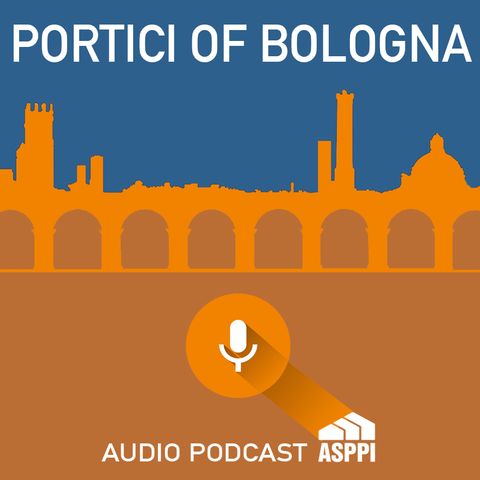Portici of Bologna. Pavaglione e dei Banchi (English)

Sign up for free
Listen to this episode and many more. Enjoy the best podcasts on Spreaker!
Download and listen anywhere
Download your favorite episodes and enjoy them, wherever you are! Sign up or log in now to access offline listening.
Description
In the 1200s piazza Maggiore was created by expropriating houses and in no time its market became the meeting place for citizens and visitors alike. For the bankers it soon...
show moreFor the bankers it soon became necessary in the area to have one location where to place the exchange offices (banchi), as there were many currencies circulating in Bologna due to the very active commercial activities from all over the country and the rest of Europe. At the beginning of the 1400s, the existing buildings around the square were still of Medieval dating with wooden colonnaded porticoes. A first re-styling took place using brick, giving the buildings Gothic style façades and the porticoes octagonal brick pilasters supporting low arches, with side-street entrances to Via Pescherie Vecchie and to Via Clavature. Under the portico dei Banchi were some of the most important commercial and financial businesses of Bologna.
In the 1500s Jacopo Barozzi, known as "il Vignola", at the time the most important architect at the Roman court and working in Bologna at the building of the Basilica of San Petronio, was called to plan a more unified and elegant front. In 1548 the magnificent Renaissance-style portico that is still to be seen today started being built, with the work completed only in 1580. In the new project the arches giving access to the side streets were evidenced by higher ones recognizable also in the façade. It is very interesting and can be called an "economy" intervention, where the completion and reorganization of the existing was preferred to a demolition and new building.
The new long façade unified buildings both towards Via degli Orefici and in front of the Ospedale della Morte, in this way presenting a unified architectural backdrop to the square and also beyond it.
The portico becomes the Portico della Morte. The property belonged to the Hospital to confort those who were condemned to death, hence the name "della morte" (of death). Under this portico is the oldest bookstore of Bologna, Libreria da Nanni. Founded in 1825 it was the first to adopt the Parisian style stalls to put books on display, of which many rare editions of the time. In more recent decades Federico Fellini, Pier Paolo Pasolini and Umberto Eco were some amongst the many famous known to browse and shop here.
The next portico is that of the Pavaglione, extending from Via De’ Musei to Via Farini, flanking Via dell’Archiginnasio and Piazza Galvani. The portico owes its name to the Piazza del Pavaglione (now Piazza Galvani) where the silkworm market used to be, of which Bologna was the most important commercial producer for many centuries. Here was a pavilion to shelter the cocoons, hence the name of the portico.
The portico is that of the Archiginnasio building, the first seat of the University of Bologna.
It was commissioned by Pope Pius IV through Carlo Borromeo who entrusted the project to Antonio Morandi known as Terribilia. It was built in just more than one year and opened in1563. The two-level façade followed the local architectural style and materials, brick and sandstone with a colonnade with Corinthian capitals and with two bigger arches marking the entrances to the side streets of the main market. To recover some of the expenses of building the church of San Petronio, shops were opened under the portico, to be rented out.
Some historical commercial activities are still under this portico today, for example one of the oldest pharmacies of the city: the Farmacia del Pavaglione originally called the Farmacia della Morte belonging to Hospital, Ospedale della Morte (Hospital) which already in the 1500s was given permission to have its own apothecary. In the 1800s under this portico opened the Zanichelli bookshop where poet Giosuè Carducci would stay every day for hours to the point that he was eventually given a private room by the shop owner to write or browse and read books. Other longstanding commercial activities here are jewellers Veronesi and the elegant Zanarini coffee bar, on the corner between piazza Galvani and via Farini where the locals like to go and enjoy refreshments after shopping or after the struscio, the Italian word which defines the stroll in the shade of the portico.
Information
| Author | ASPPI |
| Website | - |
| Tags |
Copyright 2024 - Spreaker Inc. an iHeartMedia Company
